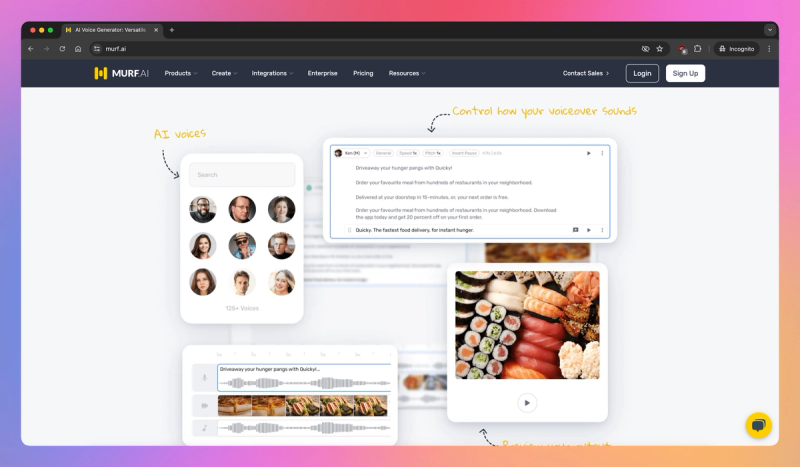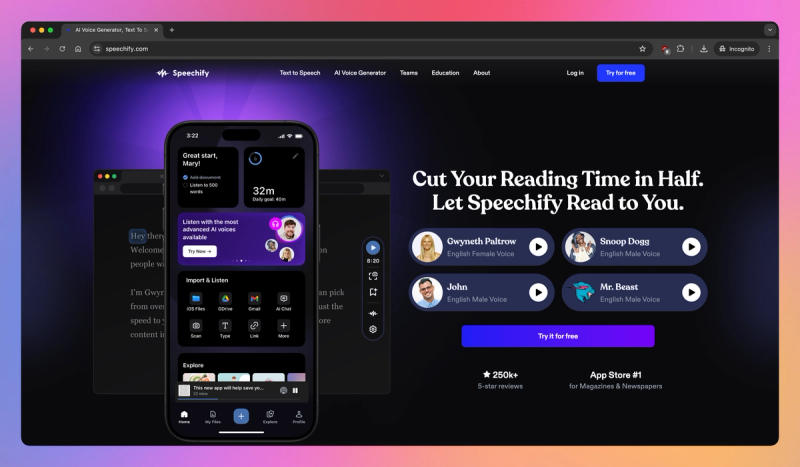The Best AI Voice Generators (in 2025)
Transform your written content into natural speech with AI voice generators. Compare top tools for creating voiceovers, podcasts, audiobooks and more with realistic text-to-speech.
Imagine telling your 2015 self that by 2025, you could generate studio-quality voiceovers in dozens of languages without ever stepping into a recording booth. Yet here we are: AI voice generators have evolved from basic text-to-speech into sophisticated tools that power everything from corporate training to viral content. Whether you're a solopreneur creating multilingual marketing videos or a developer building voice-enabled apps, these solutions are transforming how we produce and consume audio content.
In this guide, we'll explore the seven best AI voice generators of 2025, comparing their capabilities from ultra-realistic voice cloning to emotional expression. Each platform offers unique strengths for different use cases, and we'll help you find the perfect fit for your needs.
Quick look: The 7 best AI Voice Generators
 ElevenLabs Best for ultra-realistic voice cloningSee Tool
ElevenLabs Best for ultra-realistic voice cloningSee Tool
What makes the best AI Voice Generators?
Over the few months, our team has thoroughly tested dozens of AI voice generators by creating hundreds of voiceovers across different use cases - from short marketing clips to long-form narration, multilingual content, and character dialogues. This extensive testing revealed several key factors that separate the best AI voice generators from the rest:
- Voice Quality: We assessed the naturalness and clarity of generated speech. The best tools produce voices with human-like intonation, proper emphasis, and minimal robotic artifacts, even for longer content.
- Language Support: We evaluated accuracy and authenticity across multiple languages and accents. Top solutions maintain consistent quality across languages and handle pronunciation challenges effectively.
- Customization: We tested the depth of voice control options. Leading tools offer granular adjustments for speed, pitch, and emphasis while maintaining natural sound quality.
- Workflow Integration: We examined how seamlessly each generator fits into content creation processes. The best options provide robust APIs, export formats, and collaboration features that streamline professional workflows.
- Security: We evaluated responsible AI practices and data protection. Top tools implement consent mechanisms for voice cloning, clear usage rights, and secure handling of voice data.
The best AI Voice Generators at a glance
| Tool | Best For | Standout Features | Pricing |
|---|---|---|---|
| ElevenLabs | Ultra-Realistic Voice Cloning | Clone voices in one minute | Subscriptions from $5 to $330 monthly |
| PlayHT | Extensive Voice Library | 600+ voices in 140+ languages | Subscription or pay-as-you-go pricing available |
| Speechify | Personal Document Reading | Celebrity voice options available | Premium subscription at $139/year |
| LOVO AI | Multi-Format Content Creation | Complete voice and video studio | Premium plans start at $19.95/month |
| WellSaid | Professional Learning Content | Fine control over voice parameters | Premium pricing for enterprise users |
| Murf AI | Professional Multilingual Voiceovers | Robust team collaboration features | Monthly subscription with team plans |
| Podcastle | Editing Personal Voice Content | Clone your voice for editing | Monthly subscription starts at $12 |
Best AI Voice Generator for Professional Multilingual Voiceovers

Murf AI
Murf AI is one of the most popular AI voice generators, known for its balance of quality, ease of use, and robust features. It's a cloud-based platform that converts text to speech in 20+ languages with over 120 voices. Murf offers an intuitive studio interface with a rich set of tools for adjusting pacing, tone, and emphasis. It even supports voice cloning, allowing you to create a custom voice from a sample clip. Collaboration features (like project sharing and commenting) make it appealing for teams producing e-learning, marketing, or training content.
Pros
- Outstanding user interface and support, making it extremely easy to create professional voiceovers with minimal effort
- Natural-sounding voices that avoid the robotic tone of older TTS engines
- Excellent team collaboration features including project sharing, commenting, and organization tools
Cons
- Voice quality, while high, hasn't advanced as dramatically as some cutting-edge competitors
- Sometimes struggles with pronouncing unusual names or slang
- Fewer total voices and languages compared to certain rivals (about 20 languages versus 100+ in some platforms)
Best Use Cases
- Training videos, YouTube narrations, podcasts, and product explainers
- Team projects in e-learning and marketing requiring multiple voices
- Companies needing consistent voiceovers across multiple languages
Best AI Voice Generator for Ultra-Realistic Voice Cloning

ElevenLabs
ElevenLabs has quickly become a household name in AI voice generation due to its breakthrough realism. Launched in 2023, ElevenLabs offers a text-to-speech engine and voice cloning toolkit that produce uncannily human-like speech. It supports English and a growing number of other languages using its advanced neural network models. ElevenLabs is especially known for its instant voice cloning – with just a short audio sample, you can create a digital voice that closely mimics the original speaker's timbre and accent.
Pros
- Exceptional voice quality and realism that often fools listeners into thinking it's human speech
- Fast and convenient generation with straightforward web interface
- Strong emotional range and expressive capabilities in generated voices
Cons
- Can be expensive for high-volume usage
- Voice cloning requires verification to prevent misuse
- Newer languages may not be as polished as English
Best Use Cases
- Developers and creators needing ultra-realistic voice generation
- Filmmakers and game developers prototyping character dialogue
- Content creators requiring emotional range in narration
Best AI Voice Generator for Extensive Voice Library

Play.ht
Play.ht is a veteran in the text-to-speech space, known for its extensive collection of voices and straightforward API. It offers 600+ voices in 140+ languages (including multiple English accents) and has been used widely for podcasting, articles narration, and app integration. Play.ht's platform includes a web editor where you can type or paste text and select from a variety of voice styles. It also provides features like pronunciation control via SSML, and recently introduced an "ultra-realistic" voice library leveraging advanced AI models.
Pros:
- One of the largest voice libraries available with 600+ voices across 140+ languages
- Fast processing speed and reliable API performance for developers
- Consistent output that handles punctuation and tone naturally without much manual adjustment
- Affordable pricing with both subscription and pay-as-you-go options
Cons:
- Some older voices can sound robotic or monotonic
- Less advanced voice cloning capabilities compared to competitors
- UI lacks some advanced editing features found in tools like Murf or Descript
Best Use Cases:
- Content creators needing multiple voices and languages for international content
- Developers integrating text-to-speech via API
- Converting blog posts and articles to audio content
Best AI Voice Generator for Professional Learning Content

WellSaid Labs
WellSaid Labs is a premium AI voice generator that caters to professional content creators and enterprises. It emerged from an AI startup focused on high-quality speech synthesis and quickly gained traction for its exceptionally natural-sounding voices. WellSaid offers a web-based studio where users can type or paste scripts and select from a curated set of AI voices (about 50+ voices as of 2025). It stands out for "aiming for quality over quantity," providing voices that sound convincingly human and are often used in commercial e-learning, marketing videos, and even broadcast.
Pros
- Exceptional natural-sounding voices with subtle inflections and clear diction
- Precise word-by-word control over emphasis and pausing
- Strong team collaboration features with project sharing and version history
- High-quality audio export suitable for broadcast use
Cons
- Higher pricing point compared to competitors
- Relatively small voice selection compared to other platforms
- Focused mainly on professional narration rather than character voices
Best Use Cases
- Corporate training and e-learning content development
- Professional marketing and promotional videos
- Educational content requiring clear, authoritative narration
Best AI Voice Generator for Multi-Format Content Creation

LOVO AI (Genny)
LOVO AI, recently rebranded as Genny, is an AI voice generator and content creation platform that has gained a strong following. Initially known for its high-quality TTS voices, LOVO expanded Genny into a one-stop solution that includes video generation as well – but at its core, the voice synthesis remains a highlight. LOVO offers 400+ voices in 100+ languages, claiming very natural and emotionally expressive AI voices. It also provides a suite of tools like a content editor (to combine voice with visuals) and even basic video editing/timeline features. Essentially, LOVO/Genny is bridging the gap between pure voice generators and video creation platforms, making it appealing for creators who want to produce complete multimedia content with AI voices.
Pros
- Voice quality is exceptional – LOVO's voices have been favorably compared to even the likes of WellSaid and Amazon in naturalness
- The multi-modal aspect allows quick creation of promo videos or audiograms all within Genny
- Extensive language support with 100+ languages and dialects makes it ideal for international use
Cons
- UI can be complex due to many features, particularly after integrating video
- Voice cloning for custom voices isn't self-serve in the basic platform
- Some users find the video features unnecessary if they only need voices
Best Use Cases
- Content creators making YouTube videos, animated shorts, or audiobooks
- International projects requiring multi-language training or ads
- Podcast creators generating episodes or snippets with different voices
Best AI Voice Generator for Editing Personal Voice Content

Descript Overdub
Descript is a popular audio/video editing software, and one of its signature features is Overdub, an AI voice cloning tool. While Descript is not a dedicated TTS platform like others on this list, Overdub squarely qualifies as an AI voice generator – it allows you to create a clone of your own voice (or choose a stock voice) and generate speech by typing text. Descript's integration of Overdub means you can edit audio by editing text: you correct a word in the transcript, and it generates the new audio in the cloned voice seamlessly. Overdub has become a game-changer for podcasters and video producers, enabling quick fixes and even synthetic narration without having to re-record audio.
Pros
- Voice cloning is exceptionally accurate for most people, especially with clear speaking voices
- Seamlessly integrated into text-based editing workflow
- Excellent for quick fixes and updates without re-recording
- Support for multiple languages with voice cloning capabilities
Cons
- Cloned voices can sound monotone if used for long passages
- Limited selection of stock voices compared to dedicated TTS tools
- Can be resource-intensive for large projects
Best Use Cases
- Podcasters and content creators who need to make quick edits or corrections
- Voice content creators who want to prototype scripts before recording
- Multilingual creators wanting to repurpose content in different languages
Best AI Voice Generator for Personal Document Reading

Speechify
Speechify is primarily known as a text-to-speech reading app rather than a content creation tool. Available on web and mobile, Speechify converts written text (articles, PDFs, emails, etc.) into spoken audio using AI voices. It gained popularity among students, professionals, and individuals with reading difficulties (like dyslexia or ADHD) for its ability to turn any text into a listenable format. Speechify offers a range of very natural voices and has branded itself with celebrity voice options too (they famously have Gwyneth Paltrow and Snoop Dogg as voices for certain content).
Pros
- Exceptionally natural voice cadence that makes long listening sessions pleasant
- Cross-platform support with seamless syncing between devices
- Handles multiple formats including PDFs and images through OCR technology
- Celebrity voice options add unique variety to the listening experience
Cons
- Limited fine-tuning options for voice customization
- Premium subscription is relatively expensive
- Free version has restricted voice selection and character limits
Best Use Cases
- Students and professionals who need to consume large amounts of written content
- Individuals with reading difficulties seeking an audio alternative
- Content creators wanting quick audio versions of written materials
Conclusion
AI voice generators have revolutionized audio content creation, enabling anyone to produce professional voiceovers in multiple languages without traditional recording. From e-learning and marketing to app development and content creation, these tools offer unprecedented flexibility and efficiency. As the technology continues advancing, they're becoming increasingly indispensable for modern digital communication.





